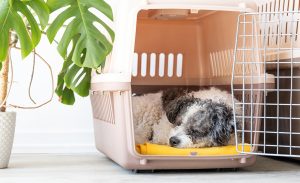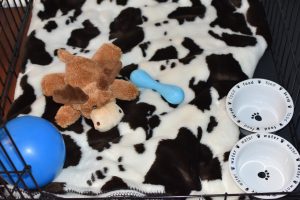Crate training can be one of the best things you do for your dog, turning their crate into a personal cozy retreat. Not only does it help with house training by teaching them boundaries, but it also gives them a safe space to relax and unwind, reducing anxiety.
The key to success? Make the process fun and stress-free as possible for both you and your pup! With the right approach, your dog will see their crate as a place of comfort rather than confinement. Let’s explore how you can turn crate training into an easy, enjoyable experience for both you and your furry friend!
Picking the right crate is like finding the perfect home for your dog. There are a few different types to consider:
Each type of crate has its perks—just find what suits your and your dog’s style!

Make sure the crate is large enough for your dog to stand, turn around, lie down, and stretch out comfortably. Too small, and it feels cramped; too big, and you may risk accidents in the crate. This is where crate dividers come in handy so the space can grow with your pup.
It is a great idea to measure your dog to ensure the crate is a suitable size. With them standing, you can measure their length from the tip of their nose to the tip of their tail. You can measure height while they are sitting, by measuring from the top of their head to where their front feet meet the floor. You would then add 3-4 inches to each measurement to ensure optimal comfort!
Pick a spot that’s quiet but still part of the family action, like a cozy corner in the living room/family room. Always leave the door(s) open so then can freely go in and out of their safe space. Your pup will be more likely to relax in their crate when they can still hear you and be around you.
For safety reasons, you want to keep them out of direct sunlight and away from heating sources. Even in the winter, our pets can easily overheat, and they would not have the ability to move away from it.
It’s important to make the crate feel comfy and inviting, like a cozy retreat, rather than cold and isolating, so your dog sees it as a safe, happy space to relax!
Transform your dog’s crate into a comfy hideaway by adding soft bedding, pet blankets or a cozy mat, but keep your pup’s behavior in mind! If your dog loves to chew or shred, opt for more durable, chew-resistant materials to prevent any destruction or emergency vet visits. Some dogs prefer the cooler surface and may even do better without blankets or beds.
Add a few favourite toys for entertainment, but also consider calming tools like soothing sounds and pheromone sprays designed to reduce anxiety and create a sense of calm. Many pet parents will leave the radio or tv on, so they don’t feel as alone.
If suitable, you can keep some of their toys or bedding in bed with you for a night before adding to the crate so they can find comfort in your smell. These small touches can make the crate feel extra safe and relaxing, turning it into the ultimate retreat for your pup!
Getting your pup comfortable in a crate, young and old, can take anywhere from a few minutes to several days and is very dependent on their comfortability and past experiences. Patience will be the most important thing.
At first, we would recommend tossing a couple treats they like into the crate, and see how comfortable they are going in. All doors should be open to ensure they don’t feel like they will get trapped. If they do go in, give lots of praise but be careful not to spook them. You can do this a few times and then leave the door open for them to explore at their own pace.
We can also introduce them with play time. Encourage playtime around the crate, progressing closer and closer to the crate. Have them play inside the crate with toys and treats. Hide and seek games with treats is a fantastic idea to get them used to being inside of it. We can start to introduce command training to go into their crates with “on your bed” or “in your crate” “crate time”, etc.

One of the best ways to get them used to their crate is feeding their meals in them. This all helps them associate their crate with positive activities like food and playtime. It is crucial to not treat the crate as a place of punishment as they will associate it with being in trouble instead of the safe haven it is meant to be.
Make crate time exciting by introducing interactive toys and puzzle feeders! These toys keep your pup mentally engaged, happy and relaxed while in the crate. A puzzle feeder or snuffle mat filled with treats keeps them busy and creates positive associations with crate time.
Rotate toys to keep things fresh, and your dog will quickly see their crate as a fun, rewarding space rather than just a nap spot. The more engaging you make it, the more they’ll look forward to spending time in their cozy den!

Crate time doesn’t have to be boring—toss in a favourite high value treat or chew to make it extra enjoyable! Long-lasting chews, like bully sticks or bones, keep your pup entertained and happy in their crate.
Just remember, safety first! Always supervise while they’re chewing, especially their first time with a new toy or treat. This ensures they are playing safely, and nothing gets swallowed or broken off that shouldn’t be.
This is meant for crate training when you’re home and helping them get comfortable—it’s all about building positive associations before you start leaving them alone.
Once they are more comfortable in their crate, eating their meals and taking their naps inside, we can start closing the door. When eating or snoozing, you will close the door but open it and letting them outside as soon as they finish or wake up. Gradually increase the time they stay in the crate with the door shut, helping them get used to it.
Once they’re comfortable with the door closed while eating or sleeping, practice leaving them in the crate with a toy or chew for short periods while you’re in another room. Plan this for after playtime or a walk, when they’re tired and more likely to settle down. Keep gradually increasing the time, and once they’re fully comfortable, you can start scheduling crate time for when you leave the house.
When first leaving the house do not make a big fuss about it and get them excited right before. This can result in more anxiety. Have them enter their crate, provide a toy, chew, or treat with a calm goodbye. Keep the time your away short, 5–10-minute coffee run or walk to get the mail.
Gradually increasing the time to errands, sit down dinner, or a movie. Pay attention to their behaviour and if they are becoming hesitant of their crate, you may be moving too fast for them. Revert back to the step they were last comfortable and progress slowly.

In the journey of crate training, patience and positivity are your best friends! With a little time and effort, you can turn the crate into a cozy haven where your pup feels safe and happy.
Remember to stay consistent and keep things fun—fill it with toys, treats, and love, and soon your dog will see their crate as a special retreat. Before you know it, they’ll be wagging their tail at the sight of it, ready for some cozy crate time!
Keeping our pet’s mind and body active is essential for their overall well-being! Pets, like us, thrive when they have both mental stimulation and physical activity.
Interactive toys and puzzle feeders are a fantastic way to challenge your furry friend, keeping them engaged and preventing boredom. It lets them utilize their natural instincts of hunting and foraging for food. They also offer some hidden health perks—like improving digestion, maintaining healthy weight, and promoting mental health.
These fun and functional tools are more than just toys; they help create a happier, healthier lifestyle for our pets!
Interactive toys and puzzle feeders are clever tools designed to challenge your pet’s brain while keeping them active. Interactive toys, like treat-dispensing balls and snuffle mats, make your pet work for their rewards, encouraging problem-solving and play.
Puzzle feeders, such as slow feeders, are designed to make mealtime more engaging, slowing down fast eaters and promoting better digestion. There is a lot of overlap and crossover between the two with their benefits and format. You may find an interactive toy like a Kong can be used as a slow feeder with their wet food.
These fun items turn everyday activities into exciting challenges, helping our pets stay mentally sharp and physically healthy!

Puzzle feeders and interactive toys are like brain games for our pet, keeping their mind sharp and engaged! These clever tools make our furry friends think, solving problems to earn treats or food, which helps reduce boredom, anxiety, and depression.
Mental stimulation can be surprisingly tiring, leaving our pet happily exhausted after working their brain. Regular engagement also boosts problem-solving skills and may even slow down cognitive decline as they age, potentially helping with conditions like Canine Cognitive Dysfunction (CCD).
Many refer to CCD as “Doggy Alzheimer’s” as you see similar symptoms such as, forgetfulness, repetitive behaviours, changes in sleeping patterns, looking lost, and increased anxiety. The best recommendation is to keep the brain active and stimulated to strengthen the memory and keep it functioning at it’s best.
So not only do these toys provide entertainment, but they also give our pets a satisfying mental workout keeping their minds strong and happy!
These puzzle toys aren’t just for brainpower—they’re also a wonderful way to keep your pet’s body in shape! When your furry friend plays with treat-dispensing balls or puzzles, they get plenty of physical exercise that helps them stay fit and maintain a healthy weight.
As they move around and interact with these fun gadgets, they’re burning off calories and staying active, which helps prevent obesity and keeps them in tip-top shape.
Additionally, slowing down their eating helps them feel more satisfied by their meal and they feel fuller when they are finished. This also results in less begging for more food or human food from us.

Puzzle feeders and food dispensing toys are like digestive superheroes for our pets, making mealtime both fun and beneficial! When our furry friends use a puzzle feeder, they eat more slowly, which helps prevent choking. It also prevents them from gorging on the food with it all coming back up moments later.
This slow eating also reduces the amount of air swallowed, a key factor in preventing bloat and Gastric Dilatation-Volvulus (GDV). GDV is a serious condition where the stomach expands with gas and twists on itself, which can be life-threatening.
It is extremely painful and deep chested breeds are more predisposed to GDV. This includes breeds like Great Danes, St Bernards, Standard Poodles, Dobermans, and Old English Sheepdogs. By encouraging slower eating, puzzle feeders help minimize the risk of this dangerous condition.
Additionally, the challenging design of interactive toys and feeders promotes thorough chewing and proper mechanical food breakdown. As your pet works to retrieve their meal, they chew more slowly, which helps in the initial digestion process.
This thorough chewing breaks food into smaller, more manageable pieces, aiding in better digestion and nutrient absorption. This means less chance of overeating, reduced risk of gastrointestinal upset, and a happier, healthier gut for our companions!
Interactive toys and puzzle feeders are the perfect way to keep your pet out of trouble! These fun challenges keep your furry friend engaged, reducing boredom and lessening separation anxiety, which are often at the root of those troublesome habits.
By giving them a fun challenge, these tools help channel their energy into something productive, like figuring out how to get a tasty treat. Instead of chewing up your favourite shoes, or scratching the furniture, your pet stays happily occupied with brain-boosting tasks.
Plus, the mental and physical effort they put in can tire them out, making them less likely to engage in destructive behavior later. It’s a win-win: a happy, busy pet and an intact home!

Interactive toys and puzzle feeders come in a range of materials to suit our pet’s preferences and feeding style.
By choosing the right material, we can cater to our pet’s eating habits, dietary needs, and cleaning preferences!
For pets that love to chew or are prone to destructive behavior and/or boredom, it’s important to keep an eye on them during puzzle time, especially with new toys! Soft materials like snuffle mats, lick mats, and even some plastic puzzles can be tempting for a pet who’s more focused on tearing things apart than solving the puzzle. It is always a great idea to supervise sessions to ensure playtime is fun and safe!
Interactive toys and puzzle feeders offer a delightful blend of benefits for your pet! They keep our furry friends mentally sharp, physically active, and aid in better digestion by promoting slower, more thorough eating. These clever tools also help prevent negative behaviors by channeling excess energy into positive activities.
Are you ready to enhance your pet’s life? Visit with our healthy pet associates to find the perfect interactive toys and puzzle feeders for your furry companion. Try these fun solutions and watch your pet enjoy a happier, healthier lifestyle!